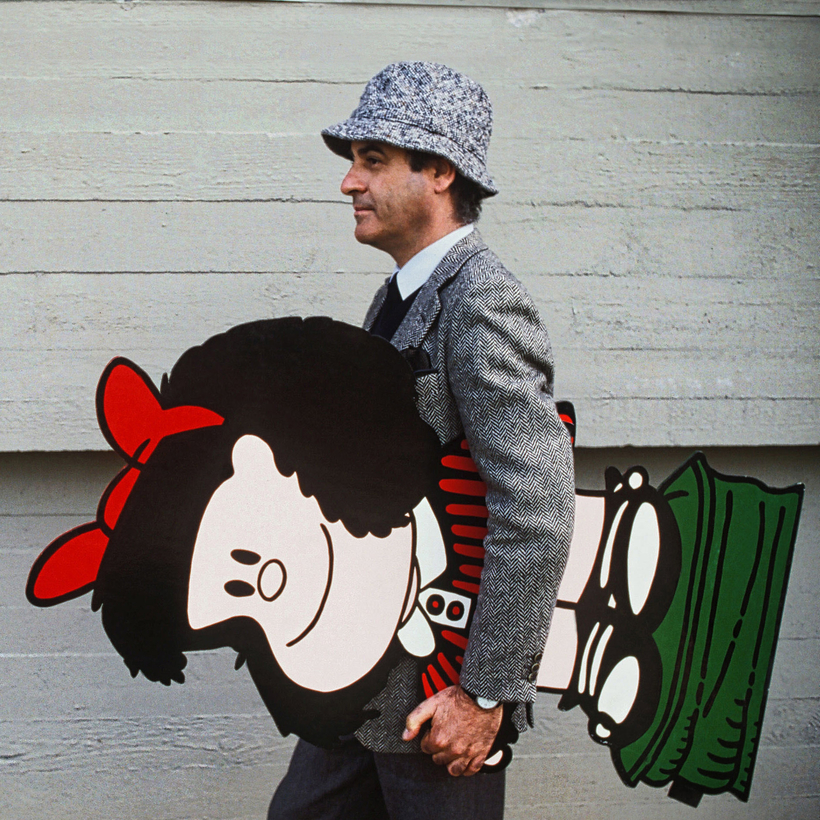On a bench in the San Telmo neighborhood of Buenos Aires, Argentina, there sits a statue of a beaming six-year-old girl in a lime-green dress and a ribbon in her bell-shaped hair. There’s another one like it, wearing ruby red this time, in a park in Oviedo, Spain. The girl’s name is Mafalda, and between 1964 and 1973 she was Argentina’s most beloved fictional character. Admirers of Mafalda and her creator, Quino, included Gabriel García Márquez, Charles M. Schulz, and Umberto Eco, who called her “a hero of our time.”
Half a century later, “Mafalda” remains the world’s most popular Latin American comic strip. In Argentina, her face adorns mugs and T-shirts alongside those of Che Guevara and Evita. Abroad, she is an emblem of mischievous dissent, popping up on placards at political demonstrations and in 2021’s The Suicide Squad. Last year, she presented the kids’ categories at the International Emmy Awards. A collection of the best strips, newly translated into English, will be published in April, and a Netflix animated series is in the pipeline. Mafalda lives.
In 1968, Confirmado magazine called Mafalda “the most in-touch-with-reality cartoon character that Argentina has ever known.” Imagine Lucy from “Peanuts” with the politics of John Lennon. Mafalda loved democracy, equal rights, and the Beatles; she hated war, injustice, and soup, a food that came to symbolize all kinds of social evils. In a typical strip, she would ask her frazzled parents a question about the world that was both childishly simple and impossible to answer: “You’re a grown-up, mama, can you explain the war in Vietnam?” or “Papa? Can you explain why humanity is a disaster?”
When the weekly magazine Siete Días took over running “Mafalda,” in 1968, it introduced its creator as “tall, skinny, otherworldly, dishevelled, electrified by flashes of energy, like a cartoon.” Quino was born Joaquín Salvador Lavado Tejón in Mendoza in 1932. His family, who had migrated from Spain, called him “Quino” to distinguish him from his uncle Joaquín, an illustrator who inspired him to draw, too. Quino was already a celebrated artist when, in 1963, he was commissioned to create a “Peanuts”-style strip to promote the household-appliance brand Mansfield. The campaign was junked, but Mafalda bounded from the wreckage, debuting in the Buenos Aires–based magazine Primera Plana on September 29, 1964.
“Mafalda is me,” Quino once said. Often seen tending a battered globe, she lived in a time of coups and juntas, permanent crisis at home, and war and upheaval abroad. Quino used the character to satirize everything from the United Nations and hyper-inflation to the space race and nuclear war. He steadily expanded Mafalda’s cast of friends to include bumptious junior capitalist Manolito, naïve artist Felipe, and spiky revolutionary Libertad. They were inspired by people he knew, and each one embodied a facet of Argentina’s precarious middle class, with Mafalda herself representing the progressive liberal wing.
Through syndication, “Mafalda” reached two million readers a day in Argentina alone and many more in Latin America and Europe. By 1968, when student protests swept the world, Mafalda had become an icon of protest: against not just the authoritarian president, Juan Carlos Onganía, but older generations. “If my generation turns out as bad as yours then we’re doomed!” she wails to her dad.
Quino used irony and ambiguity to dodge the censors. Mafalda was just a child, after all. In one strip, she is playing at government with her friends and her mother tells her not to get into trouble. “Don’t worry,” she replies. “We have lots of policies, but we don’t actually do anything!”
Yet Quino could not walk that tightrope forever. As Argentinean society grew more divided in the 1970s, his liberal humanism fell afoul of both extremes. The right deemed him too subversive while the Marxists accused him of “pathetic reformism that leads nowhere.” Political reality was outpacing the charming provocations of “Mafalda.”
When Quino retired the strip on June 25, 1973, he claimed he had run out of things to say, but he subsequently confessed to a more urgent motive: “If I had continued drawing her, they would have shot me.” He left Argentina for Milan shortly after the military coup of March 1976. Asked later to imagine Mafalda in adulthood, he said bluntly that she would have been one of the junta’s 30,000 victims. It was a time, he said, “when smiling was a threat and laughing out loud a risk.”
Returning home in 1983 after the fall of the junta, Quino created more explicitly political cartoons. He only revived “Mafalda” on special occasions, such as UNICEF’s Convention on the Rights of the Child in 1976 and, shortly before his death from a stroke, in 2020, a coronavirus-awareness campaign.
The longevity of “Mafalda” comes as no surprise when you read the strips. You don’t need to be familiar with the complexities of Argentinean society in the 60s and 70s to relate to her blend of idealism, indignation, and impatience. “It’s sad to think that the issues she talked about at that time still exist,” Quino said in 2000. “The world she criticized in ’73 is the same or worse.” And so it continues. Mafalda’s innocent questions still sting.
Dorian Lynskey is the author of several books, including The Ministry of Truth: A Biography of George Orwell’s 1984 and Everything Must Go: The Stories We Tell About the End of the World

